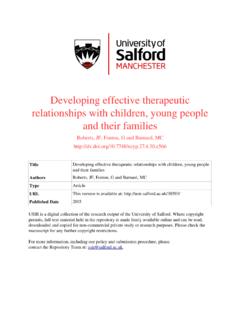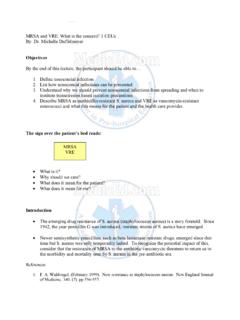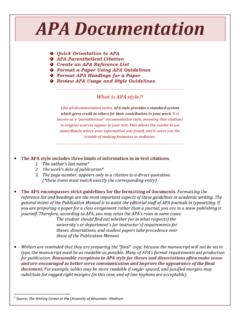Transcription of Examining the Practice of Exclusive Breastfeeding among ...
1 International journal of nursing Vol. 1, No. 1; June 2014 11. Examining the Practice of Exclusive Breastfeeding among Professional Working Mothers in Kumasi Metropolis of Ghana Janet Danso1. Abstract This study examined the Practice of Exclusive Breastfeeding among professional working mothers in Kumasi Metropolis of Ghana. The study design used for this research was cross- sectional survey. The study population consisted of professional working mothers, aged 40 or younger, who were in full-time employment and working in Kumasi metropolis of Ghana. Purposive and random samplings were also used and sample size was 1000. Questionnaire was the research instrument used in this study. From the study findings, even though the respondents were well-informed about Exclusive Breastfeeding , 48% of professional working mothers were able to Practice Exclusive Breastfeeding and 52% could not Practice Exclusive Breastfeeding according to World Health Organisation recommended Practice of Exclusive Breastfeeding .
2 The study concluded that professional working mothers find it difficult to exclusively breastfeed their babies and full time employment status and family members'. influence undermine the Practice of Exclusive Breastfeeding . It was recommended that government must guarantee that workplace is free of harassment and discrimination against women who prefer to breastfeed their babies through appropriate mechanisms and employers must provide Breastfeeding and expressing facilities at the work place to be used by Breastfeeding employees and these facilities have to be hygienic, comfortable and private and include hand washing and milk storage facilities. Keywords: Exclusive Breastfeeding , infant nutrition, breast milk, working mother Introduction Over the last two decades, there has been a growing attention in the endorsement of Exclusive Breastfeeding as the recommended feeding Practice for newborns. This, to a great degree, has been encouraged by increasing scientific substantiation on the significance of Exclusive Breastfeeding in reducing infant morbidity and mortality.
3 Exclusive Breastfeeding is the most efficient type of infant feeding for the first six months of life. The United States Breastfeeding Committee (USBC) and the American Academy of Pediatrics (AAP) declare that Breastfeeding is the physiologically normal form of infant and child feeding (Labbok & Taylor, 2008; AAP, 2012). As such, Breastfeeding should be fostered and encouraged by health care professionals and public health campaigns in order to normalize it within our culture. Numerous organisations endorse breast milk as the optimal source of nutrition for infants (American Academy of Family Physicians [AAFP], 2008; AAP, 2012; USBC, 2009; United States Department of Health and Human Services [USDHHS], 2011; World Health Organization [WHO], 2001). These organisations support Exclusive Breastfeeding for the first six months of an infant's life for multiple reasons. 1. Faculty of Public Health and Allied Sciences, Catholic University College of Ghana, Fiapre, Sunyani, and Ghana Health Service, Asaam Health Centre, c/o Asante Mampong Municipal Health Directorate, P.
4 O. Box 424, Asante Mampong, Ashanti Region, Ghana. Email: American Research Institute for Policy Development 12 International journal of nursing Vol. 1, No. 1; June 2014. In resource inadequate settings where deprived and sub-optimal Breastfeeding practices regularly result to child undernourishment which is a key cause of more than half of all child deaths (Sokol et al. 2007), Exclusive Breastfeeding is regarded as crucial for infants' continued existence. Undeniably, of the million under five children who were reported dead globally in 2011, an estimated 1 million lives could have been saved by undemanding and accessible practices such as Exclusive Breastfeeding (WHO, 2012). Subsequently, the WHO and UNICEF (1990) have recommended Exclusive Breastfeeding for six months, followed by beginning of complementary foods and sustained Breastfeeding for 24 months or more. The Practice of not giving breast milk has been connected with unexpected infant death syndrome and other neonatal morbidity and mortality.
5 Breastfeeding can save premature infants from life intimidating gastro-intestinal diseases such as necrotizing enterocolitis. It lessens the occurrence of otitis media, severe bacterial infections such as meningitis, bacteremia, lower respiratory infections and botulism (Feldman, 1999). In developing countries, there is a tendency to extend Breastfeeding for longer periods in time. In Ghana, women breastfeed for a median duration of 22 months with of women Breastfeeding their young babies. Regrettably, the rates of Exclusive Breastfeeding are less than overall breast feeding rates due to the Practice of giving complementary feedings. The addition of additional foods and liquids causes higher rates of diarrheal illness and higher mortality rates (Aidam, Perez-Escamilla & Lartey, 2005). Infants and children in developing countries are inexplicably affected by life threatening diseases, poor health care, and lack of potable water, malnutrition, poverty, and war. In an endeavour to give these children a chance at survival, it is imperative that Breastfeeding be promoted and supported by government organizations and the medical establishment.
6 Statement of Problem The benefits of Exclusive Breastfeeding for both mother and child are universally acknowledged by health providers, global health agencies, and lay people. In Ghana, an estimated 84% of children younger than 2 months are being exclusively breastfed. By age 4 to 5 months, nevertheless, only 49%. continue to receive Exclusive Breastfeeding (Ghana Statistical Service & ICF Macro, 2009 p. 187). Many attempts and hard work to promote Exclusive Breastfeeding have achieved less than desired outcomes and in order to comprehend and appreciate the dynamics of the Practice , a number of studies have been conducted in Ghana and in many parts of the world. Much of these studies have focused on factors and barriers to Exclusive Breastfeeding (Aidam et al. 2005; Otoo et al. 2009; Senarath et al. 2010). Several studies have looked at the health outcomes of Exclusive and non Exclusive Breastfeeding (Duncan et al. 1993; Coutsoudis et ; Kramer, 2003); whereas others have also considered the prospective position of husbands in Breastfeeding decisions (Arora et ; Susin, et al.)
7 2008). Much less attempts however, have been made at Examining the Practice of Exclusive Breastfeeding among professional working mothers particularly in sub Saharan Africa. This research is therefore an undertaking to realise the present knowledge gaps. Objectives of the Study The main objective of the study was to examine the Practice of Exclusive Breastfeeding among professional working mothers in Kumasi Metropolis of Ghana. The specific objectives of the study were the following: 1. To examine the sources and knowledge of Exclusive Breastfeeding information among professional working mothers Kumasi Metropolis. American Research Institute for Policy Development International journal of nursing Vol. 1, No. 1; June 2014 13. 2. To determine if professional working mothers know the benefits of Exclusive Breastfeeding Practice . 3. To assess if employment status affect Exclusive Breastfeeding Practice among professional working mothers. 4. To identify the extent of Exclusive Breastfeeding Practice among professional working mothers.
8 5. To offer recommendation to help the realisation of Exclusive Breastfeeding Practice . Research Questions The main research question for the study was what is the rate of Practice of Exclusive Breastfeeding among professional working mothers in Kumasi Metropolis of Ghana? Specific questions were the following: 1. What are the sources and knowledge of Exclusive Breastfeeding information among professional working mothers in Kumasi Metropolis? 2. Do professional working mothers know the benefits of Exclusive Breastfeeding Practice ? 3. Does employment status affect Exclusive Breastfeeding Practice among professional working mothers? 4. What is the extent of Exclusive Breastfeeding Practice among professional working mothers? Significance of the Study Millennium Development Goals item four of the eight is completely and totally dedicated to reducing child mortality by two-thirds between 1990 and 2015; with few years to 2015, nonetheless, steps forward in a lot of Africa countries is deficient in accomplishing this goal.
9 Poor feeding practices such as sub-optimal Breastfeeding is still pervasive and frequently leads to undernourishment which is a foremost cause of more than half of all child deaths (Sokol et al. 2007). Through research and identifying the Practice of Exclusive Breastfeeding among professional working mothers in Ghana will add to an enhanced appreciative of how indispensable health interventions with established and confirmed empirical effectiveness including as Exclusive Breastfeeding can be enhanced and promoted. Again, it is believed that this research's findings will add to the rising body of scientific understanding and knowledge on newborn feeding practices and how to plan and position health interventions among professional working mothers. Additionally, this research will certainly provide a basis for future research. Literature Review What is Exclusive Breastfeeding ? According to World Health Organization Exclusive Breastfeeding means that the infant receives only breast milk.
10 No other liquids or solids are given not even water with the exception of oral rehydration solution, or drops/syrups of vitamins, minerals or medicines'. Breast milk is the natural and original first food for babies, it provides all the energy and nutrients that the infant needs for the first months of life, and it continues to provide up to half or more of a child's nutritional needs during the second half of the first year, and up to one-third during the second year of life. WHO recommends that infants should be exclusively breastfed for the first six months of life to achieve optimal growth, development and health. Thereafter, infants should receive nutritionally adequate and safe complementary foods, while continuing to breastfeed for up to two years or more'. Breast milk contains all the nutrients infant requirements in the first six months of life. American Research Institute for Policy Development 14 International journal of nursing Vol. 1, No. 1; June 2014. It protects against common and widespread childhood diseases such as diarrhoea and pneumonia, and may also have longer-term benefits such as lowering mean blood pressure and cholesterol, and reducing the prevalence of obesity and type-2 diabetes.





